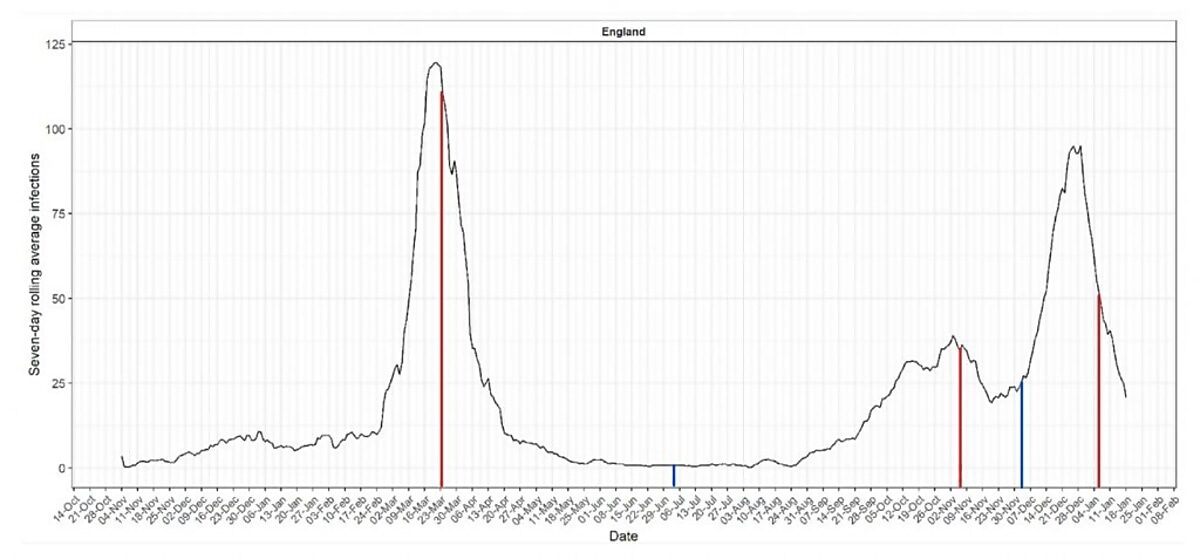
It's a very useful graph because it does not involve any PCR tests at all, only lateral flow immunoassay tests, self-administered at home. This means it does not suffer from the problem of detecting non-infectious virus as it is not detecting virus at all but antibodies. (Its specificity is reported as 98.6%, giving it a 1.4% background false positive rate, which the researchers adjust for.) This means, for example, that the epidemic decline is much faster than in the familiar "case" curves, and the curves are more symmetrical.
What does it show? Here's what I take from it. You might see more.
Firstly, it provides further evidence that SARS-CoV-2 was circulating at low levels in England throughout December 2019 and to some degree also in November. This fits with widespread anecdotal evidence of people falling ill with Covid symptoms in December. It doesn't fit with the original official timeline of an outbreak beginning in Wuhan in December.
Secondly, despite circulating widely during the winter of 2019-20, SARS-CoV-2 did not undergo fast spread in England until the end of February. Indeed, the winter of 2019-20 was the least deadly on record in terms of age-adjusted mortality, despite SARS-CoV-2 being around and infecting people.
Then, around February 25th 2020, it suddenly launches into a three-week long spike of extraordinary exponential growth. This abruptly comes to an end around March 17th, and after a short plateau till around March 21st it enters just as extreme a decline. This is all ahead of the first lockdown on March 23rd of course.
The mystery is: what happened on February 25th (or thereabouts - we don't know whether Imperial's assumptions about the incubation period are exactly right) to cause a virus that had been circulating for at least three months at a low level suddenly to go bang and spread like wildfire? It wasn't panic - no one was panicking at the end of February. Mobility levels were still normal until around March 12th. There was nothing unusual about the weather. Suggestions on this welcome in the comments below.
The second mystery is what caused it to stop? Not lockdown, obviously - several days too late. Social distancing? It's a possibility, given the timing. But notice that infections also go into decline around October 19th and November 3rd, neither of which is after a lockdown (the second lockdown began on November 5th). Also, the winter surge enters steep decline around December 29th, well before the third lockdown began on January 5th. In fact, the Christmas period when people were mixing with families and experts issued dire warnings of a Christmas surge is when the infections suddenly stopped growing and began to plunge.
In every case, then, infections plateau, peak and fall before lockdowns come in, and even during times of unusually intense household interaction.
Conversely, we can also see that infections suddenly stopped falling and began rising again around November 20th, nearly two weeks before the lockdown was lifted on December 2nd. So infections fell before the lockdowns and sometimes rose during them. What's the point of lockdown again?
One last point: this time last year infections had dropped to zero and there was no summer ripple like we're currently experiencing. Yet it was certainly seasonality and not lockdowns causing it as there was no surge in infections during the busy "Eat Out to Help Out" summer once reopening happened in July. Presumably the Delta variant is playing a part in this, though it's safe to say it's highly unlikely to be as bad as SAGE is predicting.
Reference: Helen Ward, Graham Cooke, et al., REACT-2 Round 5: increasing prevalence of SARS-CoV-2 antibodies demonstrate impact of the second wave and of vaccine roll-out in England, medRxiv Pre-print, BMJ doi.org/10.1101/2021.02.26.21252512



Reader Comments
The only "intervention" needed in hindsight was the elimination of teevee and all Legacy Media. This includes Farcebook/Twatter...